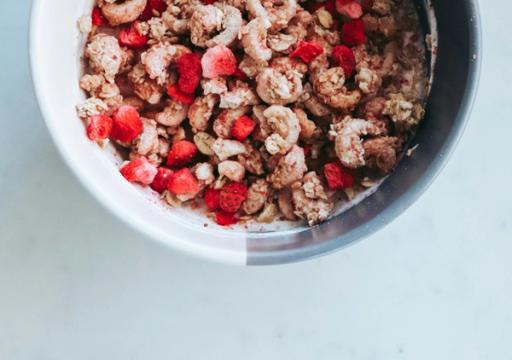When it comes to measuring calories, not all calories are created equal. For instance, you may focus on carbohydrates or protein when tracking your diet. But what about fat? Sure, fat gets a bad rap, but dietary fat is essential for health and an energy source for exercise. To optimize your performance, you must learn to measure fat intake and calculate calories from fat. This article will show you how to calculate calories from fat to accurately track your fat consumption and optimize your diet for better energy levels, muscle growth, or fat loss, leading to improved fitness performance and overall health. So, how are calories measured?
Goldi AI’s calorie tracker can help you achieve your goals. With this easy-to-use tool, you can quickly and accurately measure the calories from fat in your food to get the precise data you need to optimize your diet for better health and performance.
How To Calculate Calories From Fat

Fats are one of the three essential macronutrients, along with carbohydrates and proteins, and they play a critical role in your body’s function and overall well-being.
Here’s why fats are indispensable:
- Hormone Production: Fats are integral to producing key hormones like estrogen, testosterone, and cortisol. These hormones regulate metabolism, immune response, and reproduction, which are vital for everyday health and athletic performance.
- Nutrient Absorption: Some vitamins, such as A, D, E, and K, are fat-soluble, meaning they depend on dietary fat for absorption. Without adequate fat intake, your body might struggle to absorb these essential nutrients, potentially leading to deficiencies and compromised health.
- Cellular Structure and Function: Fats form a significant part of every cell membrane in your body. They provide the necessary flexibility and structure that allows cells to function correctly, controlling what enters and exits each cell.
Fats are an Energy Source
Fat is the most energy-dense macronutrient, providing 9 calories per gram—more than double the calories supplied by carbohydrates and proteins, each offering four calories per gram. This high energy density makes fats particularly important in several key scenarios:
- Endurance Activities: During prolonged physical activities like marathon running or cycling, your body turns to fat stores for energy once carbohydrate reserves are depleted. This makes fat a vital fuel source for sustained endurance efforts.
- Caloric Surplus and Weight Gain: Fats can help boost caloric intake without consuming large quantities of food for those seeking to increase muscle mass or body weight. Their energy density allows for a higher calorie intake in a relatively smaller portion size. Certain groups, such as very active individuals or pregnant and nursing females, may require more calories to meet their physiological or activity demands.
- Survival Situations: In times of limited food availability, your body will turn to stored fat as an energy reserve, metabolizing fat for energy to allow survival for extended periods without food.
Understanding Calories and Weight Loss
Calories are the energy units our bodies use to function, and understanding how many calories we consume versus how many we burn is crucial for managing body weight. When we eat, our bodies use the calories from food to fuel daily activities like breathing, moving, and maintaining body temperature.
Any excess calories are stored as fat, leading to weight gain. Conversely, when we consume fewer calories than our bodies need, we tap into stored fat for energy, resulting in weight loss. This fundamental principle underscores the importance of monitoring caloric intake to achieve and maintain a healthy weight.
Reading Nutrition Labels to Identify Total Fat Content
To manage fat intake effectively, it’s essential to understand the information on food nutrition labels.
Here’s what you need to know:
- Total Fat: This number reflects the total grams of fat in one serving of the food. It includes all types of fat (saturated, unsaturated, and trans fats) and is crucial for calculating calories from fat.
- Saturated Fat: Often listed separately, saturated fats should be consumed in moderation because they are associated with increased cholesterol levels and a higher risk of heart disease.
- Trans Fat: Typically highlighted due to its adverse effects on health, trans fats are linked to heart disease and inflammation. Current health guidelines strongly recommend minimizing or eliminating trans fat intake.
- Serving Size: Pay close attention to the serving size, as the listed fat content corresponds to one serving. If you consume more than one serving, you must multiply the fat content accordingly to get an accurate count of your total fat intake.
Food composition databases and mobile apps are valuable resources for comprehensive nutrient information. They provide nutrient breakdowns, including fat content, for a wide range of foods, whether you’re dining out or preparing meals at home.
Calculating How Many Calories from Fat
The process of calculating calories from fat is straightforward. The key is to remember the conversion factor: 1 gram of fat equals 9 calories. To determine the calories from fat in any food, multiply the fat grams by 9. Example Calculation: A food item contains 15 grams of fat per serving. Here’s how to calculate the calories from fat: 15 grams of fat x 9 calories per gram = 135 calories from fat
Understanding the Role of Weight in Caloric Needs: BMR and TDEE Explained
Knowing this allows you to manage your overall caloric intake more effectively, especially if you follow a specific dietary plan or fitness regimen.
Your current weight plays a crucial role in determining your daily caloric needs, as it influences your basal metabolic rate (BMR) and total daily energy expenditure (TDEE).
Calculating Daily Calorie Needs
Knowing how many calories your body needs daily is essential for weight management. Several factors influence daily caloric needs, including age, gender, weight, height, and activity level. A calorie calculator can help estimate these needs by considering these variables.
For instance, a sedentary woman might require 1,600-2,000 calories daily, while an active man might need 2,400-2,800 calories. These estimates provide a starting point, but individual needs can vary. Regularly reassessing your caloric needs as your weight and activity level change is key to maintaining a balanced diet.
Determining the Body Fat Percentage from Calories
In addition to calculating the total calories from fat, it’s helpful to understand what percentage of a food’s total calories come from fat. This can help you determine whether a food aligns with your macronutrient goals. To calculate the percentage, divide the calories from fat by the total number of calories in the food, then multiply by 100. Example Calculation: If a food item contains 135 calories from fat and a total of 300 calories: (135 calories from fat ÷ 300 total calories) x 100 = 45% of calories from fat
Understanding Fat Percentage in Foods for Better Dietary Choices
This percentage gives insight into how much of a food’s energy comes from fat, helping you make informed decisions about whether it fits your dietary goals. This straightforward method helps you assess and manage the type and amount of fat consumed daily, contributing to a healthier diet and lifestyle.
Calculating Calories from Fat: Examples
Example 1: Avocado An avocado contains approximately 29 grams of fat. To calculate calories from fat, multiply the fat grams by 9, as each gram equals 9 calories. Therefore, the calculation would be 29g × 9 = 261 calories from fat.
Example 2: Almond Butter Two tablespoons of almond butter typically have 18 grams of fat. Use the formula 18g × 9 = 162 calories from fat. This simple multiplication gives the energy contribution from fats in almond butter.
Example 3: Salmon Fillet A 200-gram salmon fillet usually contains about 22 grams of fat. Applying the calorie calculation, 22g × 9 = 198 calories are derived from fat in one serving of salmon fillet.
Example 4: Cheddar Cheese For a 30-gram serving of cheddar cheese containing 10 grams of fat, the calories from fat would be calculated as 10g × 9 = 90. This figure represents the caloric content of fat in the cheese serving.
How Do I Find How Much Fat Is In My Food?

Check the Label First!
Check the nutrition label to find out how much fat is in food. This will tell you the total fat per serving. Use nutrition databases, food-tracking apps, or restaurant websites for information if no label exists. If discussing homemade meals, know that you can estimate the fat content by summing the fat in individual ingredients.
Keep a Food Journal to Track Your Fat Intake
Consider keeping a food journal or using a nutrition tracking app to ensure you get the right fat. By logging your meals and snacks, you can monitor your fat consumption and ensure you meet your dietary goals.
A food journal can also help you spot patterns, such as excessive intake of unhealthy fats or insufficient consumption of omega-3s, allowing you to make adjustments as needed. Consulting with a registered dietitian can be beneficial for personalized advice, especially if you have specific health conditions or fitness goals.
Set a Goal Weight to Help Monitor Fat Intake
Setting a goal weight can help monitor fat intake and achieve dietary goals by determining the caloric intake needed to reach that weight within a specific time frame.
How Do I Find How Much Fat Is In My Food?
We can easily find the amount of fat in our food and meals by looking at the nutrition labels and then using a food scale to determine how many grams of fat are in them. This calculator will give you the exact number of recommended grams of fat, and then you need to track the calories in your food to reach that recommendation.
Reading the serving sizes and comparing them with your portion sizes can be helpful. You could even have some pre-determined portion sizes that you always go to for easier calorie tracking. Counting your macros doesn’t have to be challenging, but getting used to it may take a little time.
What Types of Fats Are Best?
Not all fats are created equal; we must aim for healthier fats when reaching our goals.
- Unsaturated fats, both monounsaturated and polyunsaturated, are considered to be the healthier fats, along with omega-3 fatty acids.
- Monounsaturated fats contain one or more double bonds between the carbons, and they will be stable in room-temperature environments.
- Polyunsaturated fats have one or more double bonds between the carbons, and they are unstable and liquid when at room temperature.
Choosing Healthy Fats: The Benefits of Unsaturated and Omega-3 Fatty Acids
Ideally, we will get most of our fats from these unsaturated and omega-3 fatty acids. Unsaturated fats include:
- Avocados
- Nuts
- Soybeans
- Corn oils
For omega-3 fatty acids, we should look for food items like:
- Nuts
- Fish
- Canola oil
We have saturated fats, which are the fats that need to be avoided the most.
Understanding Saturated, Trans, and Omega-6 Fats: Impact on Health and How to Limit Them
These fats contain single bonds and will become solid at room temperature. Butter and coconut oil are examples of saturated fats. Omega-6 fatty acids are also present in the diet and shouldn’t be focused on too much as they can cause blood vessel clotting over the long term.
Another form of fat that isn’t preferable is trans fats, partially hydrogenated oils associated with a higher risk of heart disease. In summary, around 10 percent of our calories should come from the saturated fats in the diet, and the rest should come from unsaturated fats.
Does the Consumption of Fats Make Me Fat?
In short, no, the only thing that makes you fat is the overconsumption of calories. So, eating fats does not make you fatter, as long as you eat the number of calories to maintain or lose weight.
Most people believe the contrary, but you must eat fat as part of a healthy diet, fulfill hormonal roles, and maintain cell membranes’ health. Without fat present in the body, you would be unable to process and utilize essential micronutrients like vitamins A, D, E, and K.
Track Your Calories within Less Than 15 Seconds with Our Calorie Tracker App
Gone are the days of tedious manual logging and calorie-tracking apps.
Goldi AI transforms calorie tracking with cutting-edge AI technology. Just snap a photo of your meal, and we’ll do the rest.
Our app combines your phone’s depth sensor with advanced AI models to:
- Analyze food volume
- Identify ingredients
- Instantly calculate calories, protein, carbs, and fat content.
With 90% accuracy on visible foods and multiple tracking options like:
- Barcode scanning
- Food label recognition
- Manual descriptions for complex items like smoothies
We’ve made nutrition tracking effortless. Whether you’re scanning a full meal or a quick snack, Goldi AI
- Provides nutritional information in under 15 seconds
- Eliminates the need for tedious manual logging.
Our AI learns from your feedback to improve accuracy. It includes personalized insights and smart reminders to keep you on track. Goldi AI makes achieving your fitness goals simpler than ever. Track your calories with your camera using Goldi AI’s calorie tracker today!



